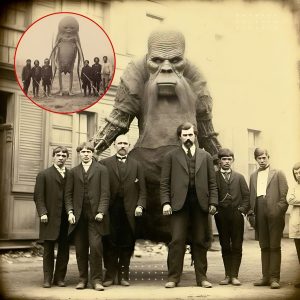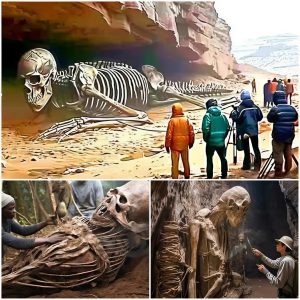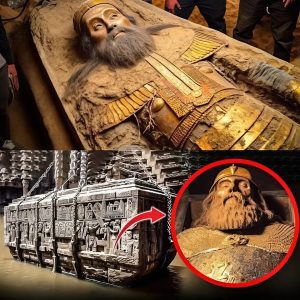Who Was Gilgamesh?
- Historical and Mythological Significance: Gilgamesh is a central figure in ancient Mesopotamian mythology, particularly in the “Epic of Gilgamesh,” one of the oldest known literary works. The epic portrays Gilgamesh as a demi-god, two-thirds divine and one-third human, known for his extraordinary strength, wisdom, and a quest for immortality.
- Epic Adventures: The epic recounts his heroic deeds, including his battles with supernatural beings, his deep friendship with Enkidu, and his journey to the ends of the earth in search of eternal life. Gilgamesh’s story has been a cornerstone of ancient literature, influencing countless cultures and inspiring numerous adaptations throughout history.

Details of the Tomb and the Body
- The Intact Body: The body found in the tomb is extraordinarily well-preserved, measuring an estimated 12 to 15 feet in length. This immense size aligns with ancient depictions of Gilgamesh as a giant figure, larger than life both literally and metaphorically. The body is adorned with intricate jewelry and clothing, suggesting royal status and great wealth.
- Artifacts and Inscriptions: Surrounding the body were a variety of artifacts, including weapons, ceremonial objects, and inscribed tablets. The cuneiform inscriptions on these tablets repeatedly mention the name Gilgamesh, as well as references to his deeds and his divine heritage. These inscriptions provide further evidence linking the tomb to the legendary king.
- The Tomb’s Design: The tomb itself is a marvel of ancient engineering, with its walls covered in detailed carvings that depict scenes from the epic, such as Gilgamesh’s encounters with the gods and his battle with the Bull of Heaven. The craftsmanship of the tomb suggests it was built by highly skilled artisans, possibly under the direct orders of a ruling dynasty seeking to honor Gilgamesh’s memory.
Implications of the Discovery
- Myth Becomes Reality: The discovery of Gilgamesh’s tomb challenges the boundary between myth and history, suggesting that the legendary figures of ancient texts may have been based on real individuals who were later deified or mythologized. This find could lead to a reevaluation of other mythological tales and their potential historical roots.
- Impact on Archaeology and History: If confirmed, the identification of the body as Gilgamesh could revolutionize our understanding of ancient Mesopotamian history and culture. It might provide new insights into the origins of the epic and the historical context in which Gilgamesh lived and ruled.
- Scientific Investigation: The discovery opens up new avenues for scientific research, including DNA analysis, carbon dating, and the study of the tomb’s artifacts. These investigations could yield valuable information about the era in which Gilgamesh lived, the burial practices of the time, and the physical characteristics of the legendary king.





